page 5
(The Study of Threes)
http://threesology.org
Visitors as of 11/18/2019
| Pages in the Biological & Physiological 3s Series: | ||
| B/P 3s pg. 1 | B/P 3s pg. 2 | B/P 3s pg. 3 |
| B/P 3s pg. 4 | B/P 3s pg. 5 | B/P 3s pg. 6 |
| B/P 3s pg. 7 | B/P 3s pg. 8 | B/P 3s pg. 9 |
| B/P 3s pg. 10 | B/P 3s pg. 11 | The Devil's Advocate and 3s Research |
3 basic bacteria (prokaryote cell) shapes:
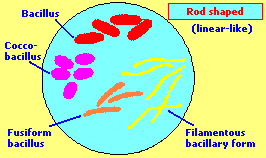 |
The Bacillus is the rod-shaped form (note variations). |
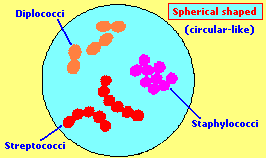 |
The Coccus is the spherical type. A pair of cocci = diplococci A chain of cocci = streptococci A grape-like cluster = staphylococci |
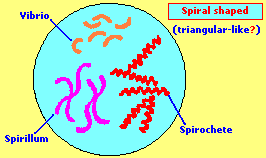 |
The Vibrio, Spirillum, and Spirochete are
spiral-shaped. (The Spirillum and Spirochete forms exhibit triangular impressions. Can you see them?) |
In the third image, the Spirochete can be called linear, although the jagged form suggests triangles. The Vibrio can be called circular, although they are but half circles. The Spirillum, if cut at the apex, point or middle, are like two triangles put together at their tips. Hence, this is a grouping of linear, circular, triangular forms.
http://www.duke.edu/web/bio103/study/study2.html
3 architectural (structural) regions to a procaryotic cell:
- Appendages (attachments to the cell surface) in the form of flagella and pili (or fimbriae).
- A cell envelope consisting of a capsule, cell wall and plasma membrane.
- A cytoplasmic region that contains the cell genome (DNA), ribosomes and various sorts of inclusions.
3 parts to Flagella (prokaryotic different from eukaryotic):
- Filament - composed of flagellin proteins twisted together in a helical conformation.
- Hook - transition between filament and motor.
- Basal body - anchor in cell wall and motor.
http://www.calpoly.edu/~selrod/Lecture02biochemanat.html
3 examples of techniques that have been developed to demonstrate bacterial motility, (Since motility is a primary criterion for the diagnosis and identification of bacteria:)
- Flagellar stains outline flagella and show their pattern of distribution.
- Motility test medium demonstrates if cells can swim in a semisolid medium.
- Direct microscopic observation of living bacteria in a wet mount shows transient movement of swimming bacteria.
3 layers of material that envelope or enclose the protoplasm (cytoplasm) of the cell (cell envelope):
- Plasma membrane.
- Cell wall.
- Capsule.
***In Gram-positive bacteria peptidoglycans may vary in the amino acid in place of DAP (Diaminopimelic acid) or L-lys (diamino acid L-lysine ) in position 3 of the tetrapeptide, and in the exact composition of the interpeptide bridge. {The cell walls of all Bacteria contain a unique type of peptidoglycan called murein. Peptidoglycan is a polymer of disaccharides (a glycan) cross-linked by short chains of amino acids (peptides), and many types of peptidoglycan exist.}
3 processes by which solutes enter or exit from bacterial cells:
- [1 - U...] Uniport.
- 2 - S...] Symport- (also called co-transport).
- [3 - A...] Antiport- (also called exchange diffusion).

http://www.bact.wisc.edu/Bact303/Structure
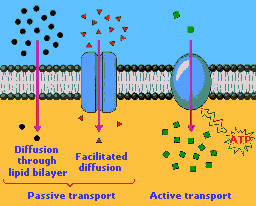
Three ways substances can move across membranes:
- Diffusion - a passive form of transport, molecules simply move across the membrane following a potential gradient.
- Facilitated Diffusion - also passive, substances must pass through a protein "filter" in the membrane, though they are still following the potential gradient.
- Active Transport - the cell uses energy (stored and "delivered" by ATP, adenosine triphosphate) to pump cells into or out of the cell AGAINST a gradient.
http://fig.cox.miami.edu/Faculty/Dana/105F00_10.html
Larger image source: --- 3 transport systems ---
http://fig.cox.miami.edu/Faculty/Dana/transport.jpg
3 categories of viruses according to their genetic make-up:
- DNA-containing viruses: Hepatitis B (100 nm); herpes simplex (100 nm); polyoma (45 nm); T-series bacterial viruses (100 x 80 nm); vaccinia 300 x 200 x 100 nm).
- Single-stranded DNA containing viruses: M13; G4 and phi-x 184 (25 nm).
- RNA-containing viruses: Tobacco mosaic virus (300 x 15 nm); mumps (17 nm); influenza (10 nm); retrovirus human T-cell leukaemia virus type III or HTLV type III, also known as HIV or AIDS virus (100 nm).
http://www.navneet.com/much_to_know/origin_of_life/11april2000/virus_life_style.html
3 cell arrangement planes in bacteria:
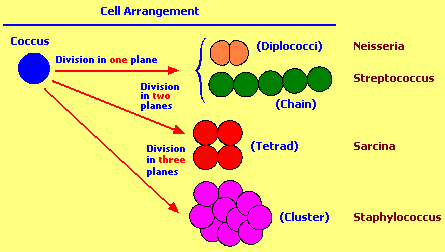
3 flagella position examples in a "One"~ "Two"~ "Many" format:
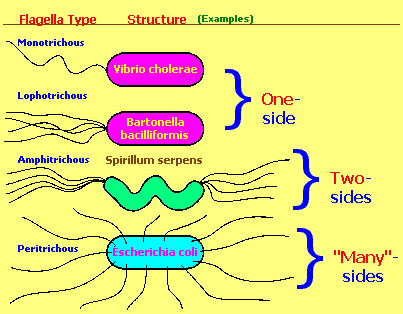
--- Cell Structure ---
http://gsbs.utmb.edu/microbook/ch002.htm
3 layers of dead cells make up a hair shaft: Medulla ~ Cortex ~ Cuticle
3 (hair) cross-sections:
- Flat, ribbon-like (African)
- Circular (Asian)
- Ellipsoid (Caucasian)
3 types of hair are distinguished:
- Soft, fine short and pale (vellus hair)
- Course, hard and large hairs (terminal hair) is found on the scalp and eyebrows
- Very fine hair in the fetus (lanugo)
3 regions of the hair shaft are distinguishable:
- Medulla: The most central cells of the matrix give rise to vacuolated cells at the core of the hair shaft. Only present in thick (terminal) hair.
- Cortex: Matrix cells peripheral to the center of the shaft.
- Cuticle: The more peripheral matrix cells. The most peripheral matrix cells form the external root sheath.
3 types of exocrine glands can be distinguished on the basis of their mechanism of secretion:
- Merocrine (usual type of exocytosis)
- Apocrine (a historical distinction related to the notion that release was accompanied by loss of cytoplasm)
- Holocrine (the cell dies and becomes part of the secretion product).
3 types of cells in the secretory portion of Eccrine glands:
- Clear cells are characterized by accumulations of glycogen and mitochondria. Their morphology is consistent with the hypothesis that the clear cells produce the watery component of sweat.
- Dark cells have abundant rER and secretory granules. The Golgi apparatus is large and the apical cytoplasm is filled with secretory granules. These cells have the intracellular organization of glycoprotein secreting cells.
- Myoepithelial cells are limited to the basal aspect of the gland wall. They lie between the secretory cells and their basal lamina. Their contraction is responsible for the expression of sweat from the gland.
http://www.medsch.ucla.edu/https/ctb/99lect/Micevych/Skin.htm
3 different types of nerve fibers (nociceptors):
- A delta 1
- A delta 2
- C fibers
| Fibre | Myelinated? | Pain perceived |
| A delta (1) fibre | yes | pressure |
| A delta (2) fibre | yes | sharp, well focused pain |
| C fibre | no | dull burning pain |
- 3 major types of brain cell damage of Alzheimer's: Plaque ~ Tangles ~ Granulovacuolar degeneration (GVD).
- 3 proteins belonging to a class known as casein kinase-1 (CK-1), normally help regulate activity within cells.
- 3 main types of dementia: Alzheimer’s disease ~ Fronto-temporal ~ Vascular.
- 3 temporary "ice" headaches: From eating ice out of a cold drink ~ From eating ice cream ~ From eating a cold fruit/vegetable
- 3 types of keratinized skin on terminal digits: Claws ~ Hooves ~ Nails
- 3 types of conditions damage particular cell layers in the hippocampus: Seizure~ Ischaemia ~ Anoxia.
| Well Established | Probable Factors | Controversial Factors |
|
|
|
http://www.indiana.edu/~w505b/DaileyPres.html
| 3 sites on the molecule of a sugar like glucose (when dissolved) form
a triangle of particular size and shape. The three sites are believed to
form bonds with three complimentary sites on the taste membrane within a
person's mouth. This theory accounts for the sweetness of a large array of
molecules and it is considered that there must be more than one such
triangle to account for genetic differences among individuals. (page 15, Leading edges in Social and Behavioral Science, edited by R. Duncan Luce, Neil J. Smelser, and Dean R. Gerstein) |
3 fundamental questions in the development of cognitive and social competence:
- What is the original state of the organism? (How should the competence of the newborn or young infant be characterized?)
- What is the subsequent course of development of competence? (Exactly how does the initial state of the baby evolve into the competence of the mature organism?)
- What is the mechanism of the developmental transformation? (An answer to the question of mechanism includes specifying the important biological ~ experiential ~ (and) social influences on development.
(page 15, Leading edges in Social and Behavioral Science, edited by R. Duncan Luce, Neil J. Smelser, and Dean R. Gerstein)
3 general types of Abortions:
- Abortion from below.
- Abortion from above.
- Using drugs to kill the unborn child (and then labor and delivery).
3 general types of drug abortions:
- Prostaglandin Abortions- Three forms, two are injected and one is a vaginal suppository.
- RU-486- A drug that produces an abortion taken after the mother misses her period.
- Miscellaneous Techniques- (such as poison).
For more information:
3 main categories of abortion methods as described by Dr. J.C. Willke, in his book, "Abortion Questions and Answers," (Hayes Publishing Co. Inc, Cincinnati, 1985):
- Those that invade the uterus and kill the child by instruments which enter the uterus through the cervix.
- Those that kill the preborn child by administration of drugs and then induce labour and the delivery of a dead baby.
- Those that invade the uterus by abdominal surgery.
***Starting September 1, 2001, the American Red Cross is refusing blood donations from people who have spent a cumulative 3 months in Great Britain or those who have spent 6 months in any part of Europe since 1980.***
3 types of Blood donors:
- Volunteer Blood Donors- As a rule, a greater percentage of better quality Blood comes from volunteer donors.
- Replacement Blood Donors- Blood donors who donate their Blood as a replacement for their own Blood, or that of a friend or relative.
- Professional Blood Donors- Blood donors who get either monetary benefit or help of various other kinds in return for the Blood that they donate. (Such donors are statistically more likely to carry some infection. Their Blood is more likely to be of a lower standard as they tend to donate more frequently.)
http://www.bloodbook.com/donr-requir.html
3 types of Sphygmomanometer (generally called a blood-pressure cuff):
- Mercury- This is the standard for blood pressure measurement.
- Aneroid- This is often inexpensive, lightweight and more portable than mercury.
- Automatic- This is contained in one unit, so it is easier to handle than systems with separate gauge and stethoscope.
3 parts to a Sphygmomanometer: Cuff ~ Pressure registering system ~ Stethoscope.
http://www.americanheart.org/hbp/do_monit.html
3 types of contact lenses:
- Soft lenses- which are more comfortable but not as durable as rigid lenses.
- Rigid lenses- which are tough and hard wearing.
- Scleral (haptic) lenses- (limited indications only).
http://www.hydron.co.uk/biocompatible_hydron_wearer_information2.html
3 major categories of sleep disorders:
- Insomnia- Lack of sleep.
- Disturbed sleep- (Obstructive sleep apnea, REM sleep behavior disorder, and restless legs syndrome & periodic limb movement).
- Narcolepsy- Too much sleep.
http://www.neurologychannel.com/sleepdisorders/types.shtml
3 sources of transplant kidneys:
- Cadaveric transplants
- Living related transplants
- Living unrelated transplants
http://www.kidney.org.uk/main/faqs.html
3 most common types of arthritis due to damaged cartilage:
- Osteoarthritis- Typically occurring as a result of aging, this disease causes cartilage to erode, eventually allowing bones to grind or rub together. Constantly straining the knee during sports or work-related activities may help bring on the problem. Excess weight can also be a factor.
- Inflammatory arthritis- This chronic disease results when, for unknown reasons, the immune system mistakenly attacks the tissue that lines and cushions the joints. As cartilage wears away, the knee often becomes stiff and swollen. A well-known example is rheumatoid arthritis.
- Traumatic arthritis- The culprit here is a bad fall or other injury that fails to heal properly. The resulting weakness places extra pressure on certain parts of the knee, causing the breakdown of cartilage.
http://www.sulzerorthopedics.com/us/patient/knee/knee_arthritis.htm
3 major types of meniscal tears:

- Bucket handle tears.
- Anterior horn tears.
- Posterior horn tears.
http://www.echo.uqam.ca/mednet/anglais/hermes_a/knee/part_4.html
3 basic types of midwives:
- Certified Nurse Midwife- A CNM is a registered nurse who has completed her master's degree in midwifery. She usually works through a hospital, obstetrician's office or birthing center. She works under the direction of a physician.
- Certified Midwife- A CM is certified by her state or midwifery organization. She has generally passed both oral and written tests, and has had her practice scrutinized. She may have received her training in a school, or in a manner similar to the lay midwife.
- Lay Midwife or Empirical Midwife- This is a woman who has apprenticed with an experienced midwife and may have attended additional workshops and classes to supplement her education. Her focus is on home-birth or she may have a birthing room available in her own home or clinic. She may be affiliated with a physician, but is not under the physician's directive.
http://www.efn.org/~djz/birth/mwtype/mwtype2.html
3 common areas of complaint for those who may only play sports on weekends or occasionally: Shoulder ~ Elbow ~ Knee.
3 general categories of Sports injuries:
- Accidents.
- Overuse injuries.
- "Lack of discretion"- which is when someone exercises inappropriately for his or her level of skill or fitness.
http://www.hopkinsmedicine.org/sportsmedicine.html
3 category division of the so-called four muscles comprising the (shoulder's) rotator cuff:
- Subscapularis
- Supra-spinatus/Infra-spinatus
- Teres minor
3 distinct types of acromion (shoulder) can readily be seen on radiographs, especially on the angled outlet Y view:
- Type I acromion- Which is flat, is the "normal" acromion.
- Type II acromion- is more curved and downward dipping.
- Type III acromion- is hooked and downward dipping, obstructing the outlet for the supraspinatus tendon.
3 stages to the impingement syndrome according to CS Neer:
- Stage I involves edema and/or hemorrhage- This stage generally occurs in patients less than 25 years of age and is frequently associated with an overuse injury. Generally, at this stage the syndrome is reversible.
- Stage II- is more advanced and tends to occur in patients 25 to 40 years of age. The pathologic changes that are now evident show fibrosis as well as irreversible tendon changes.
- Stage III- generally occurs in patients over 50 years of age and frequently involves a tendon rupture or tear. Stage III is largely a process of attrition and the culmination of fibrosis and tendinosis that have been present for many years.
http://www.aafp.org/afp/980215ap/fongemie.html
3 points to observe in maintaining a proper diet for preventing high blood pressure:
- Less liquor but more tea.
- Eat light food with less salt.
- Eat vegetable, vegetable oils and protein foods.
http://www.foodmarketexchange.com/people/health/pp_hn_pwh_food.htm
3 types of blood vessels from which we may bleed in 3 ways:
- Capillaries- are very small blood vessels that carry blood to all parts of the body.
- Veins- are blood vessels that carry blood to the heart.
- Arteries- are large blood vessels that carry
blood away from the heart.
- Inside the body- (internal bleeding)
- Outside the body- (external bleeding)
- Both Inside and Outside the body.
http://www.vnh.org/StandardFirstAid/chapter3.html
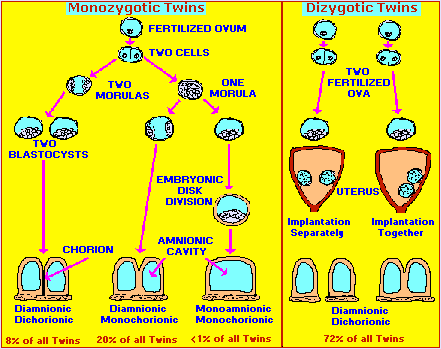
3 types of monozygotic (identical) twins:
- Diamniotic dichorionic (DiDi)
- Diamniotic monochorionic (DiMo)
- Monoamniotic monochorionic (MoMo)
(Yet 2 types of monozgotic (fraternal) twins which suggests an earlier evolutionary appearance?... with respect to the idea of a 1- 2- 3 maturational development ontogeny and phylogeny?)
3 group types of boy-girl twin combinations:
- Identical B-B/ Fraternal B-B
- Identical G-G/ Fraternal B-B
- Fraternal B-G
We have Mono = (1) zgotic twins and Di = (2) zgotic twins. Shall a third type of twin develop either as a separate entity or as a result of fusion of the Mono and Dizygotic forms appear? Or will (has?) an original Tri = zgotic twins "formula/type" come to be?
The information on twins was adapted from two sources:
http://www.straightdope.com/columns/000107.html
--- Placental Pathology ---
http://telpath2.med.utah.edu/WebPath/PLACHTML/PLAC101.html

3 primary RMI (Repetitive Motion Injury) risk factors are:
3 examples of typical Syndromes experienced:
3 examples of symptoms:
3 examples of symptoms:
3 examples of symptoms:
http://www.apple.com/about/ergonomics/uprsk.html |
Updated Posting (HTML maintenance): Sunday, 15th September 2019... 1:45 PM
Latest Update: Friday, February 24th, 2023... 11:30 AM
Herb O. Buckland
herbobuckland@hotmail.com